Ricoh Case Analysis: External Environment, Capabilities, and Future
VerifiedAdded on 2022/09/14
|7
|2192
|29
Case Study
AI Summary
This case study analyzes Ricoh Canada Inc.'s business strategies, focusing on its shift from the digital printing industry to professional and management services. The paper examines the external environmental forces impacting Ricoh, including market trends, competitor analysis (Canon, Xerox, HP, Konica Minolta, etc.), and customer behavior. It also assesses Ricoh's capabilities and competencies in technical, professional, and management services. The analysis highlights the company's strengths, such as its financial resources and workforce expertise, and its weaknesses, including a lack of a strong B2C presence and the challenges posed by intense competition. The study concludes by discussing Ricoh's strategies to address future challenges, such as organic growth, acquisitions, partnerships, and alliances, emphasizing the importance of adapting to market changes and leveraging its established market presence.
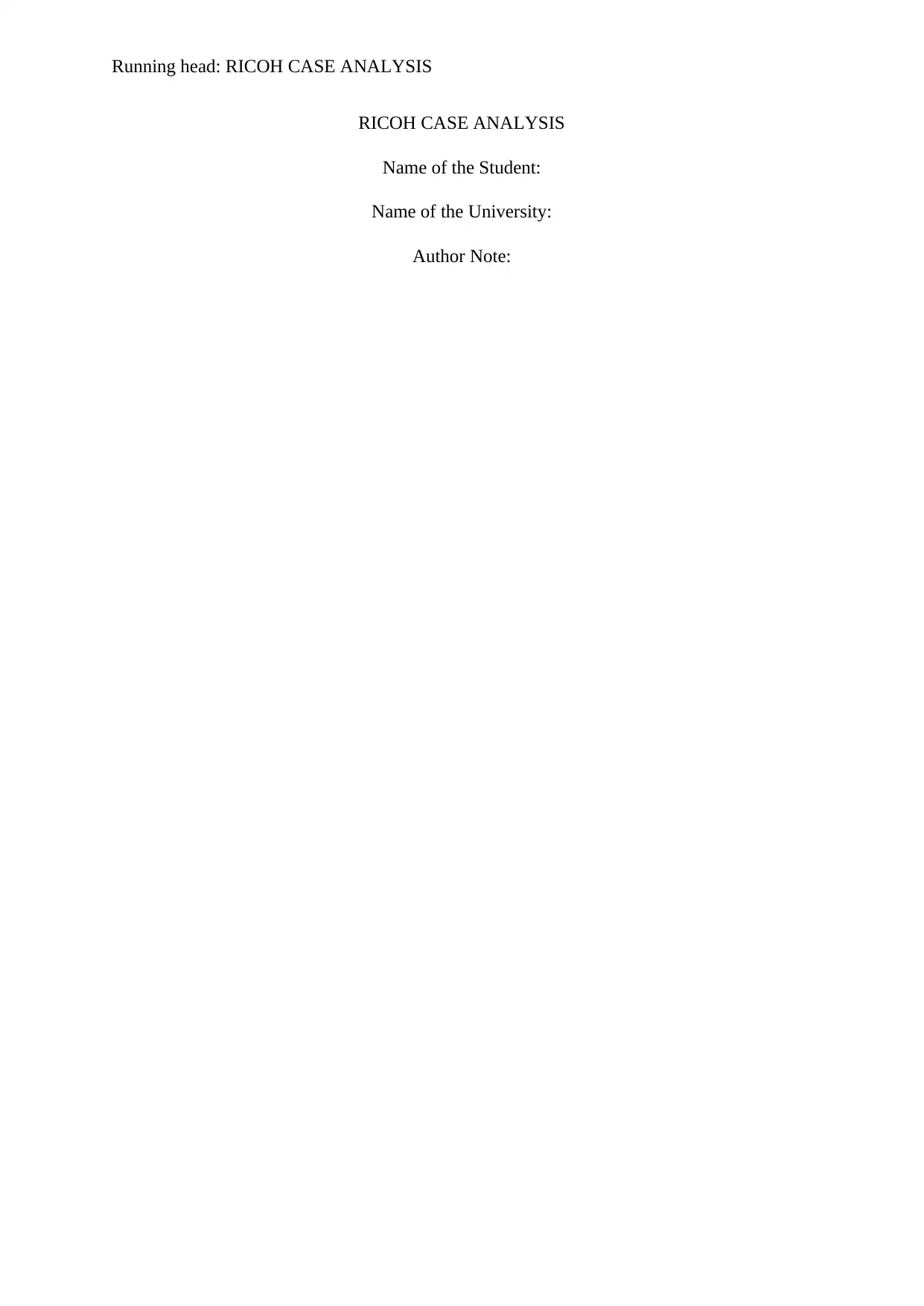
Running head: RICOH CASE ANALYSIS
RICOH CASE ANALYSIS
Name of the Student:
Name of the University:
Author Note:
RICOH CASE ANALYSIS
Name of the Student:
Name of the University:
Author Note:
Paraphrase This Document
Need a fresh take? Get an instant paraphrase of this document with our AI Paraphraser
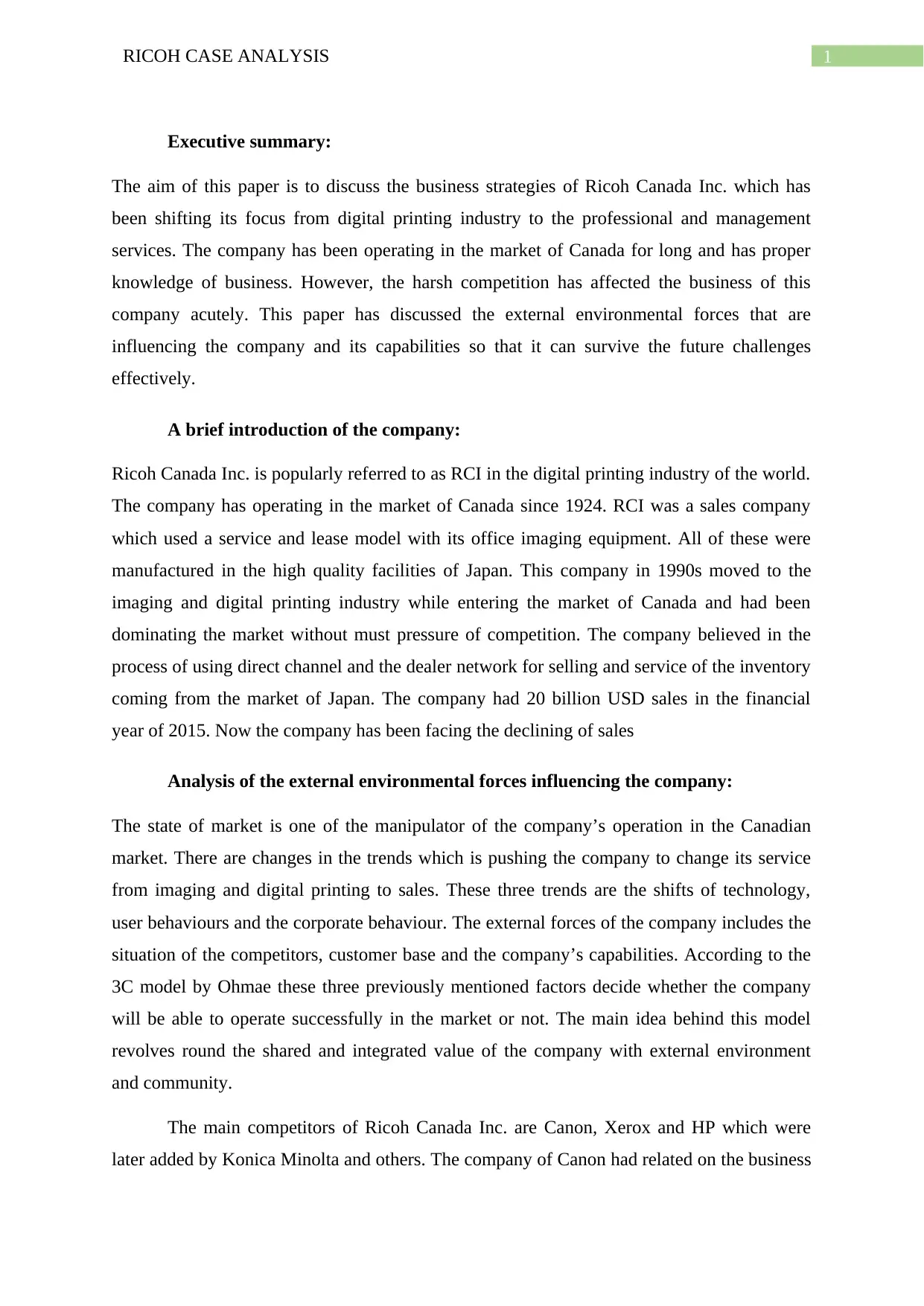
1RICOH CASE ANALYSIS
Executive summary:
The aim of this paper is to discuss the business strategies of Ricoh Canada Inc. which has
been shifting its focus from digital printing industry to the professional and management
services. The company has been operating in the market of Canada for long and has proper
knowledge of business. However, the harsh competition has affected the business of this
company acutely. This paper has discussed the external environmental forces that are
influencing the company and its capabilities so that it can survive the future challenges
effectively.
A brief introduction of the company:
Ricoh Canada Inc. is popularly referred to as RCI in the digital printing industry of the world.
The company has operating in the market of Canada since 1924. RCI was a sales company
which used a service and lease model with its office imaging equipment. All of these were
manufactured in the high quality facilities of Japan. This company in 1990s moved to the
imaging and digital printing industry while entering the market of Canada and had been
dominating the market without must pressure of competition. The company believed in the
process of using direct channel and the dealer network for selling and service of the inventory
coming from the market of Japan. The company had 20 billion USD sales in the financial
year of 2015. Now the company has been facing the declining of sales
Analysis of the external environmental forces influencing the company:
The state of market is one of the manipulator of the company’s operation in the Canadian
market. There are changes in the trends which is pushing the company to change its service
from imaging and digital printing to sales. These three trends are the shifts of technology,
user behaviours and the corporate behaviour. The external forces of the company includes the
situation of the competitors, customer base and the company’s capabilities. According to the
3C model by Ohmae these three previously mentioned factors decide whether the company
will be able to operate successfully in the market or not. The main idea behind this model
revolves round the shared and integrated value of the company with external environment
and community.
The main competitors of Ricoh Canada Inc. are Canon, Xerox and HP which were
later added by Konica Minolta and others. The company of Canon had related on the business
Executive summary:
The aim of this paper is to discuss the business strategies of Ricoh Canada Inc. which has
been shifting its focus from digital printing industry to the professional and management
services. The company has been operating in the market of Canada for long and has proper
knowledge of business. However, the harsh competition has affected the business of this
company acutely. This paper has discussed the external environmental forces that are
influencing the company and its capabilities so that it can survive the future challenges
effectively.
A brief introduction of the company:
Ricoh Canada Inc. is popularly referred to as RCI in the digital printing industry of the world.
The company has operating in the market of Canada since 1924. RCI was a sales company
which used a service and lease model with its office imaging equipment. All of these were
manufactured in the high quality facilities of Japan. This company in 1990s moved to the
imaging and digital printing industry while entering the market of Canada and had been
dominating the market without must pressure of competition. The company believed in the
process of using direct channel and the dealer network for selling and service of the inventory
coming from the market of Japan. The company had 20 billion USD sales in the financial
year of 2015. Now the company has been facing the declining of sales
Analysis of the external environmental forces influencing the company:
The state of market is one of the manipulator of the company’s operation in the Canadian
market. There are changes in the trends which is pushing the company to change its service
from imaging and digital printing to sales. These three trends are the shifts of technology,
user behaviours and the corporate behaviour. The external forces of the company includes the
situation of the competitors, customer base and the company’s capabilities. According to the
3C model by Ohmae these three previously mentioned factors decide whether the company
will be able to operate successfully in the market or not. The main idea behind this model
revolves round the shared and integrated value of the company with external environment
and community.
The main competitors of Ricoh Canada Inc. are Canon, Xerox and HP which were
later added by Konica Minolta and others. The company of Canon had related on the business
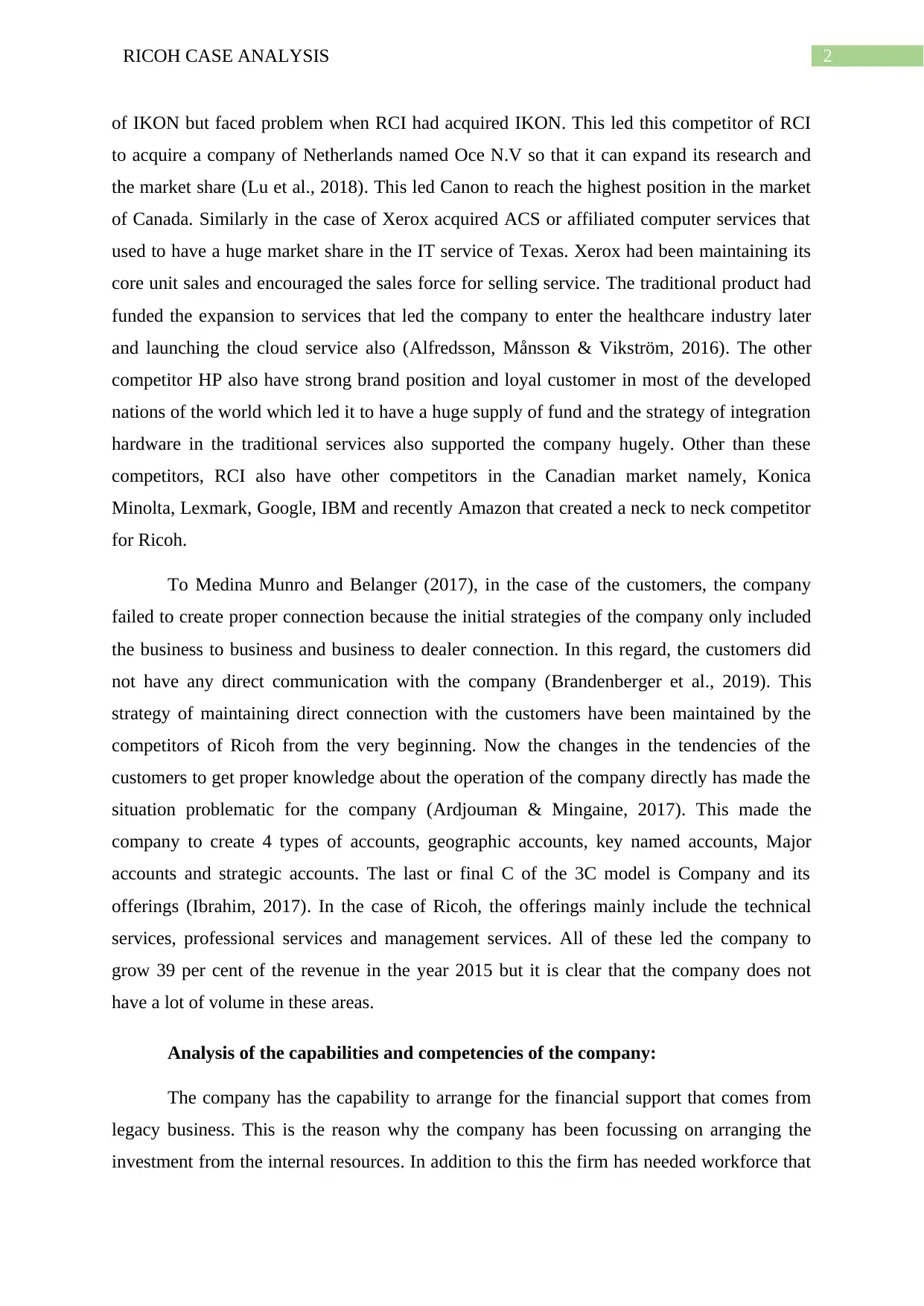
2RICOH CASE ANALYSIS
of IKON but faced problem when RCI had acquired IKON. This led this competitor of RCI
to acquire a company of Netherlands named Oce N.V so that it can expand its research and
the market share (Lu et al., 2018). This led Canon to reach the highest position in the market
of Canada. Similarly in the case of Xerox acquired ACS or affiliated computer services that
used to have a huge market share in the IT service of Texas. Xerox had been maintaining its
core unit sales and encouraged the sales force for selling service. The traditional product had
funded the expansion to services that led the company to enter the healthcare industry later
and launching the cloud service also (Alfredsson, Månsson & Vikström, 2016). The other
competitor HP also have strong brand position and loyal customer in most of the developed
nations of the world which led it to have a huge supply of fund and the strategy of integration
hardware in the traditional services also supported the company hugely. Other than these
competitors, RCI also have other competitors in the Canadian market namely, Konica
Minolta, Lexmark, Google, IBM and recently Amazon that created a neck to neck competitor
for Ricoh.
To Medina Munro and Belanger (2017), in the case of the customers, the company
failed to create proper connection because the initial strategies of the company only included
the business to business and business to dealer connection. In this regard, the customers did
not have any direct communication with the company (Brandenberger et al., 2019). This
strategy of maintaining direct connection with the customers have been maintained by the
competitors of Ricoh from the very beginning. Now the changes in the tendencies of the
customers to get proper knowledge about the operation of the company directly has made the
situation problematic for the company (Ardjouman & Mingaine, 2017). This made the
company to create 4 types of accounts, geographic accounts, key named accounts, Major
accounts and strategic accounts. The last or final C of the 3C model is Company and its
offerings (Ibrahim, 2017). In the case of Ricoh, the offerings mainly include the technical
services, professional services and management services. All of these led the company to
grow 39 per cent of the revenue in the year 2015 but it is clear that the company does not
have a lot of volume in these areas.
Analysis of the capabilities and competencies of the company:
The company has the capability to arrange for the financial support that comes from
legacy business. This is the reason why the company has been focussing on arranging the
investment from the internal resources. In addition to this the firm has needed workforce that
of IKON but faced problem when RCI had acquired IKON. This led this competitor of RCI
to acquire a company of Netherlands named Oce N.V so that it can expand its research and
the market share (Lu et al., 2018). This led Canon to reach the highest position in the market
of Canada. Similarly in the case of Xerox acquired ACS or affiliated computer services that
used to have a huge market share in the IT service of Texas. Xerox had been maintaining its
core unit sales and encouraged the sales force for selling service. The traditional product had
funded the expansion to services that led the company to enter the healthcare industry later
and launching the cloud service also (Alfredsson, Månsson & Vikström, 2016). The other
competitor HP also have strong brand position and loyal customer in most of the developed
nations of the world which led it to have a huge supply of fund and the strategy of integration
hardware in the traditional services also supported the company hugely. Other than these
competitors, RCI also have other competitors in the Canadian market namely, Konica
Minolta, Lexmark, Google, IBM and recently Amazon that created a neck to neck competitor
for Ricoh.
To Medina Munro and Belanger (2017), in the case of the customers, the company
failed to create proper connection because the initial strategies of the company only included
the business to business and business to dealer connection. In this regard, the customers did
not have any direct communication with the company (Brandenberger et al., 2019). This
strategy of maintaining direct connection with the customers have been maintained by the
competitors of Ricoh from the very beginning. Now the changes in the tendencies of the
customers to get proper knowledge about the operation of the company directly has made the
situation problematic for the company (Ardjouman & Mingaine, 2017). This made the
company to create 4 types of accounts, geographic accounts, key named accounts, Major
accounts and strategic accounts. The last or final C of the 3C model is Company and its
offerings (Ibrahim, 2017). In the case of Ricoh, the offerings mainly include the technical
services, professional services and management services. All of these led the company to
grow 39 per cent of the revenue in the year 2015 but it is clear that the company does not
have a lot of volume in these areas.
Analysis of the capabilities and competencies of the company:
The company has the capability to arrange for the financial support that comes from
legacy business. This is the reason why the company has been focussing on arranging the
investment from the internal resources. In addition to this the firm has needed workforce that
⊘ This is a preview!⊘
Do you want full access?
Subscribe today to unlock all pages.

Trusted by 1+ million students worldwide
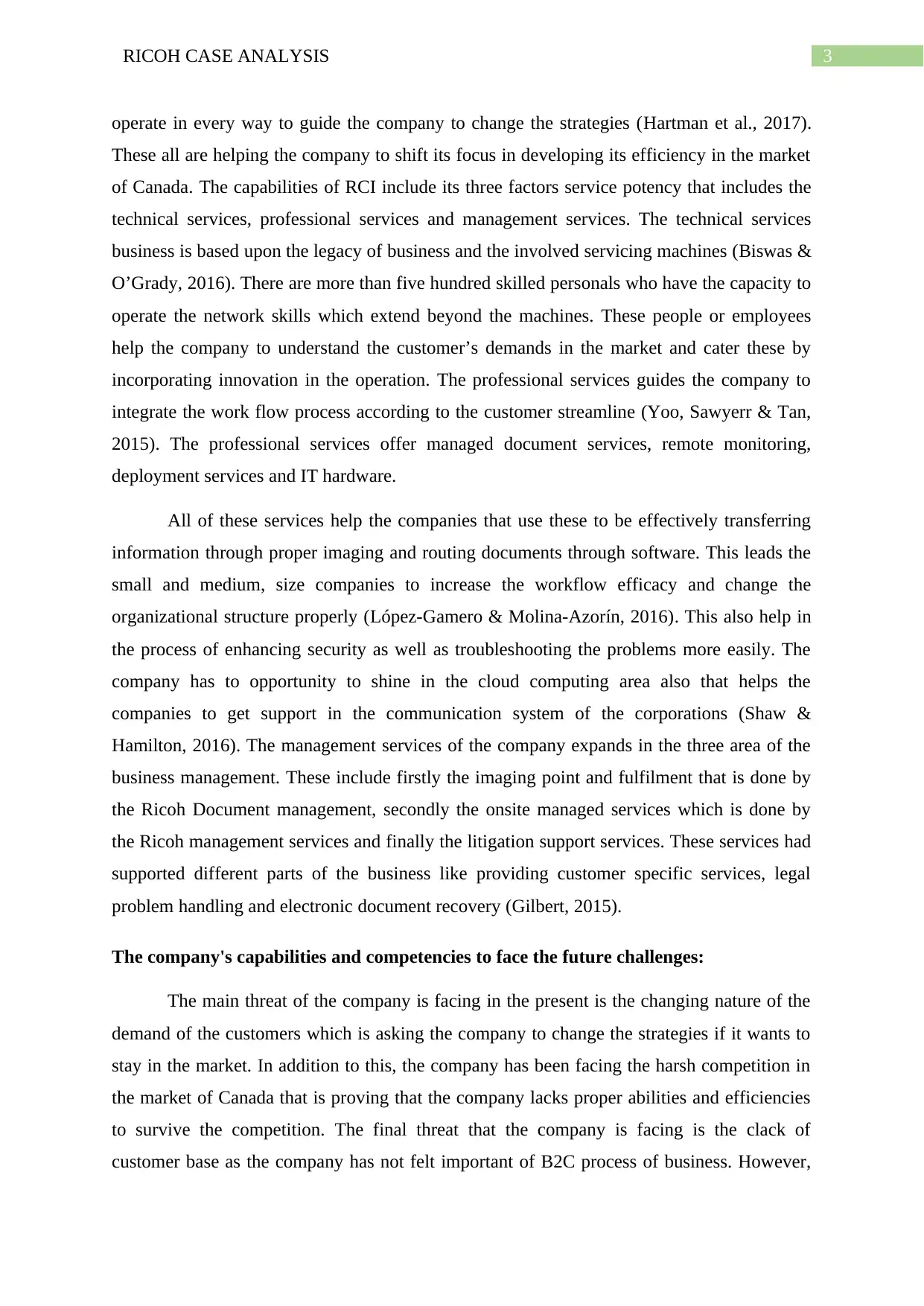
3RICOH CASE ANALYSIS
operate in every way to guide the company to change the strategies (Hartman et al., 2017).
These all are helping the company to shift its focus in developing its efficiency in the market
of Canada. The capabilities of RCI include its three factors service potency that includes the
technical services, professional services and management services. The technical services
business is based upon the legacy of business and the involved servicing machines (Biswas &
O’Grady, 2016). There are more than five hundred skilled personals who have the capacity to
operate the network skills which extend beyond the machines. These people or employees
help the company to understand the customer’s demands in the market and cater these by
incorporating innovation in the operation. The professional services guides the company to
integrate the work flow process according to the customer streamline (Yoo, Sawyerr & Tan,
2015). The professional services offer managed document services, remote monitoring,
deployment services and IT hardware.
All of these services help the companies that use these to be effectively transferring
information through proper imaging and routing documents through software. This leads the
small and medium, size companies to increase the workflow efficacy and change the
organizational structure properly (López-Gamero & Molina-Azorín, 2016). This also help in
the process of enhancing security as well as troubleshooting the problems more easily. The
company has to opportunity to shine in the cloud computing area also that helps the
companies to get support in the communication system of the corporations (Shaw &
Hamilton, 2016). The management services of the company expands in the three area of the
business management. These include firstly the imaging point and fulfilment that is done by
the Ricoh Document management, secondly the onsite managed services which is done by
the Ricoh management services and finally the litigation support services. These services had
supported different parts of the business like providing customer specific services, legal
problem handling and electronic document recovery (Gilbert, 2015).
The company's capabilities and competencies to face the future challenges:
The main threat of the company is facing in the present is the changing nature of the
demand of the customers which is asking the company to change the strategies if it wants to
stay in the market. In addition to this, the company has been facing the harsh competition in
the market of Canada that is proving that the company lacks proper abilities and efficiencies
to survive the competition. The final threat that the company is facing is the clack of
customer base as the company has not felt important of B2C process of business. However,
operate in every way to guide the company to change the strategies (Hartman et al., 2017).
These all are helping the company to shift its focus in developing its efficiency in the market
of Canada. The capabilities of RCI include its three factors service potency that includes the
technical services, professional services and management services. The technical services
business is based upon the legacy of business and the involved servicing machines (Biswas &
O’Grady, 2016). There are more than five hundred skilled personals who have the capacity to
operate the network skills which extend beyond the machines. These people or employees
help the company to understand the customer’s demands in the market and cater these by
incorporating innovation in the operation. The professional services guides the company to
integrate the work flow process according to the customer streamline (Yoo, Sawyerr & Tan,
2015). The professional services offer managed document services, remote monitoring,
deployment services and IT hardware.
All of these services help the companies that use these to be effectively transferring
information through proper imaging and routing documents through software. This leads the
small and medium, size companies to increase the workflow efficacy and change the
organizational structure properly (López-Gamero & Molina-Azorín, 2016). This also help in
the process of enhancing security as well as troubleshooting the problems more easily. The
company has to opportunity to shine in the cloud computing area also that helps the
companies to get support in the communication system of the corporations (Shaw &
Hamilton, 2016). The management services of the company expands in the three area of the
business management. These include firstly the imaging point and fulfilment that is done by
the Ricoh Document management, secondly the onsite managed services which is done by
the Ricoh management services and finally the litigation support services. These services had
supported different parts of the business like providing customer specific services, legal
problem handling and electronic document recovery (Gilbert, 2015).
The company's capabilities and competencies to face the future challenges:
The main threat of the company is facing in the present is the changing nature of the
demand of the customers which is asking the company to change the strategies if it wants to
stay in the market. In addition to this, the company has been facing the harsh competition in
the market of Canada that is proving that the company lacks proper abilities and efficiencies
to survive the competition. The final threat that the company is facing is the clack of
customer base as the company has not felt important of B2C process of business. However,
Paraphrase This Document
Need a fresh take? Get an instant paraphrase of this document with our AI Paraphraser
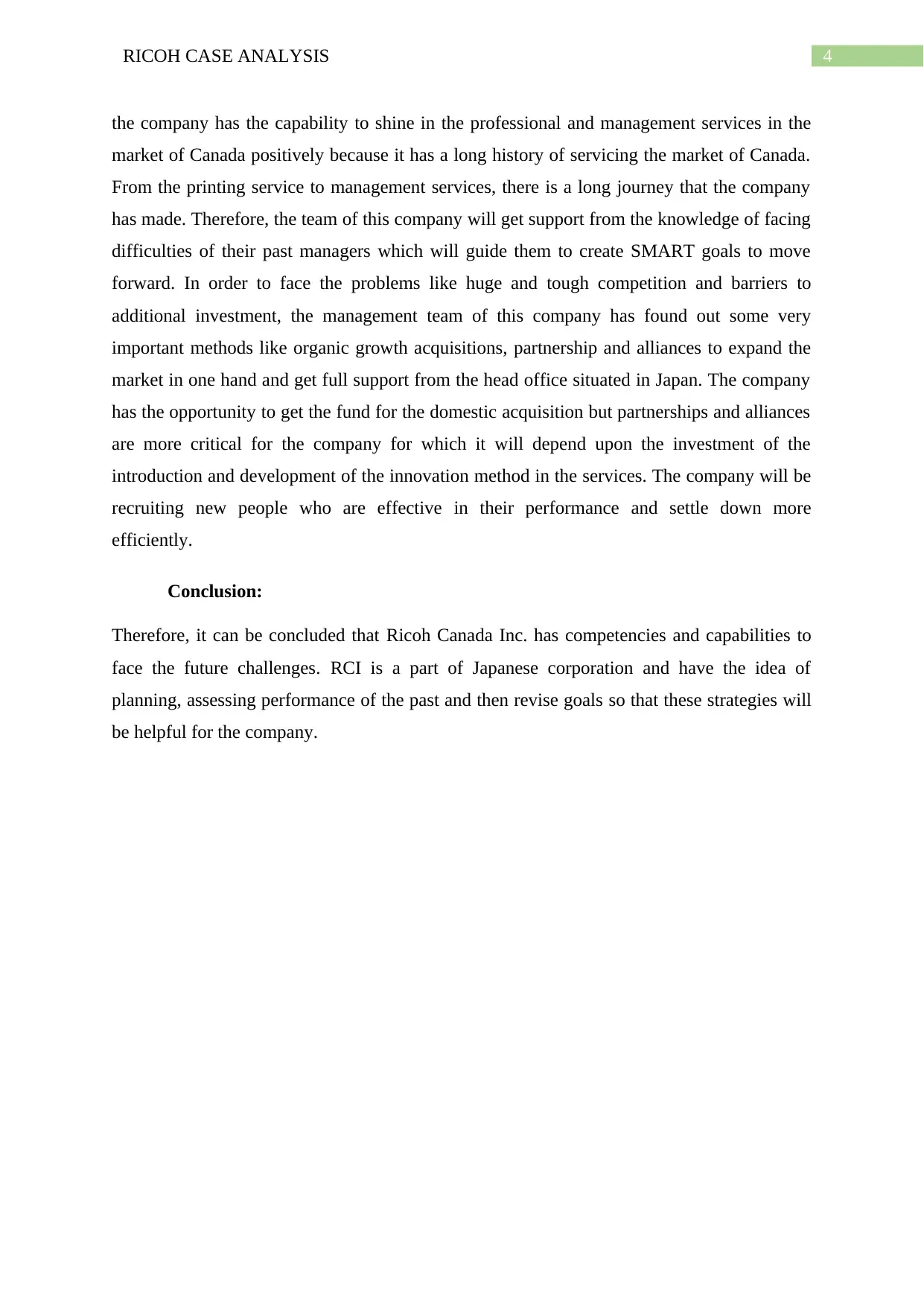
4RICOH CASE ANALYSIS
the company has the capability to shine in the professional and management services in the
market of Canada positively because it has a long history of servicing the market of Canada.
From the printing service to management services, there is a long journey that the company
has made. Therefore, the team of this company will get support from the knowledge of facing
difficulties of their past managers which will guide them to create SMART goals to move
forward. In order to face the problems like huge and tough competition and barriers to
additional investment, the management team of this company has found out some very
important methods like organic growth acquisitions, partnership and alliances to expand the
market in one hand and get full support from the head office situated in Japan. The company
has the opportunity to get the fund for the domestic acquisition but partnerships and alliances
are more critical for the company for which it will depend upon the investment of the
introduction and development of the innovation method in the services. The company will be
recruiting new people who are effective in their performance and settle down more
efficiently.
Conclusion:
Therefore, it can be concluded that Ricoh Canada Inc. has competencies and capabilities to
face the future challenges. RCI is a part of Japanese corporation and have the idea of
planning, assessing performance of the past and then revise goals so that these strategies will
be helpful for the company.
the company has the capability to shine in the professional and management services in the
market of Canada positively because it has a long history of servicing the market of Canada.
From the printing service to management services, there is a long journey that the company
has made. Therefore, the team of this company will get support from the knowledge of facing
difficulties of their past managers which will guide them to create SMART goals to move
forward. In order to face the problems like huge and tough competition and barriers to
additional investment, the management team of this company has found out some very
important methods like organic growth acquisitions, partnership and alliances to expand the
market in one hand and get full support from the head office situated in Japan. The company
has the opportunity to get the fund for the domestic acquisition but partnerships and alliances
are more critical for the company for which it will depend upon the investment of the
introduction and development of the innovation method in the services. The company will be
recruiting new people who are effective in their performance and settle down more
efficiently.
Conclusion:
Therefore, it can be concluded that Ricoh Canada Inc. has competencies and capabilities to
face the future challenges. RCI is a part of Japanese corporation and have the idea of
planning, assessing performance of the past and then revise goals so that these strategies will
be helpful for the company.
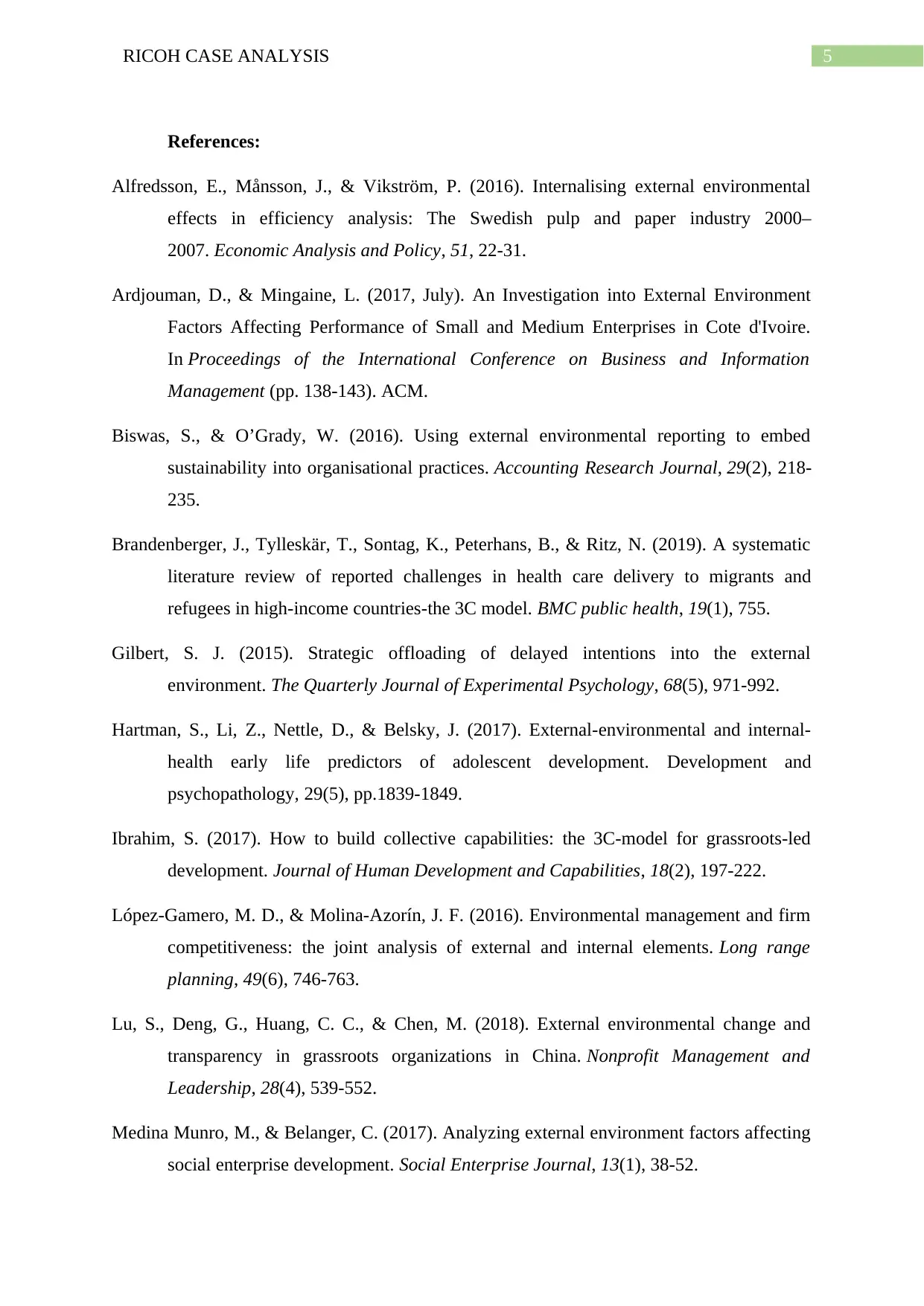
5RICOH CASE ANALYSIS
References:
Alfredsson, E., Månsson, J., & Vikström, P. (2016). Internalising external environmental
effects in efficiency analysis: The Swedish pulp and paper industry 2000–
2007. Economic Analysis and Policy, 51, 22-31.
Ardjouman, D., & Mingaine, L. (2017, July). An Investigation into External Environment
Factors Affecting Performance of Small and Medium Enterprises in Cote d'Ivoire.
In Proceedings of the International Conference on Business and Information
Management (pp. 138-143). ACM.
Biswas, S., & O’Grady, W. (2016). Using external environmental reporting to embed
sustainability into organisational practices. Accounting Research Journal, 29(2), 218-
235.
Brandenberger, J., Tylleskär, T., Sontag, K., Peterhans, B., & Ritz, N. (2019). A systematic
literature review of reported challenges in health care delivery to migrants and
refugees in high-income countries-the 3C model. BMC public health, 19(1), 755.
Gilbert, S. J. (2015). Strategic offloading of delayed intentions into the external
environment. The Quarterly Journal of Experimental Psychology, 68(5), 971-992.
Hartman, S., Li, Z., Nettle, D., & Belsky, J. (2017). External-environmental and internal-
health early life predictors of adolescent development. Development and
psychopathology, 29(5), pp.1839-1849.
Ibrahim, S. (2017). How to build collective capabilities: the 3C-model for grassroots-led
development. Journal of Human Development and Capabilities, 18(2), 197-222.
López-Gamero, M. D., & Molina-Azorín, J. F. (2016). Environmental management and firm
competitiveness: the joint analysis of external and internal elements. Long range
planning, 49(6), 746-763.
Lu, S., Deng, G., Huang, C. C., & Chen, M. (2018). External environmental change and
transparency in grassroots organizations in China. Nonprofit Management and
Leadership, 28(4), 539-552.
Medina Munro, M., & Belanger, C. (2017). Analyzing external environment factors affecting
social enterprise development. Social Enterprise Journal, 13(1), 38-52.
References:
Alfredsson, E., Månsson, J., & Vikström, P. (2016). Internalising external environmental
effects in efficiency analysis: The Swedish pulp and paper industry 2000–
2007. Economic Analysis and Policy, 51, 22-31.
Ardjouman, D., & Mingaine, L. (2017, July). An Investigation into External Environment
Factors Affecting Performance of Small and Medium Enterprises in Cote d'Ivoire.
In Proceedings of the International Conference on Business and Information
Management (pp. 138-143). ACM.
Biswas, S., & O’Grady, W. (2016). Using external environmental reporting to embed
sustainability into organisational practices. Accounting Research Journal, 29(2), 218-
235.
Brandenberger, J., Tylleskär, T., Sontag, K., Peterhans, B., & Ritz, N. (2019). A systematic
literature review of reported challenges in health care delivery to migrants and
refugees in high-income countries-the 3C model. BMC public health, 19(1), 755.
Gilbert, S. J. (2015). Strategic offloading of delayed intentions into the external
environment. The Quarterly Journal of Experimental Psychology, 68(5), 971-992.
Hartman, S., Li, Z., Nettle, D., & Belsky, J. (2017). External-environmental and internal-
health early life predictors of adolescent development. Development and
psychopathology, 29(5), pp.1839-1849.
Ibrahim, S. (2017). How to build collective capabilities: the 3C-model for grassroots-led
development. Journal of Human Development and Capabilities, 18(2), 197-222.
López-Gamero, M. D., & Molina-Azorín, J. F. (2016). Environmental management and firm
competitiveness: the joint analysis of external and internal elements. Long range
planning, 49(6), 746-763.
Lu, S., Deng, G., Huang, C. C., & Chen, M. (2018). External environmental change and
transparency in grassroots organizations in China. Nonprofit Management and
Leadership, 28(4), 539-552.
Medina Munro, M., & Belanger, C. (2017). Analyzing external environment factors affecting
social enterprise development. Social Enterprise Journal, 13(1), 38-52.
⊘ This is a preview!⊘
Do you want full access?
Subscribe today to unlock all pages.

Trusted by 1+ million students worldwide
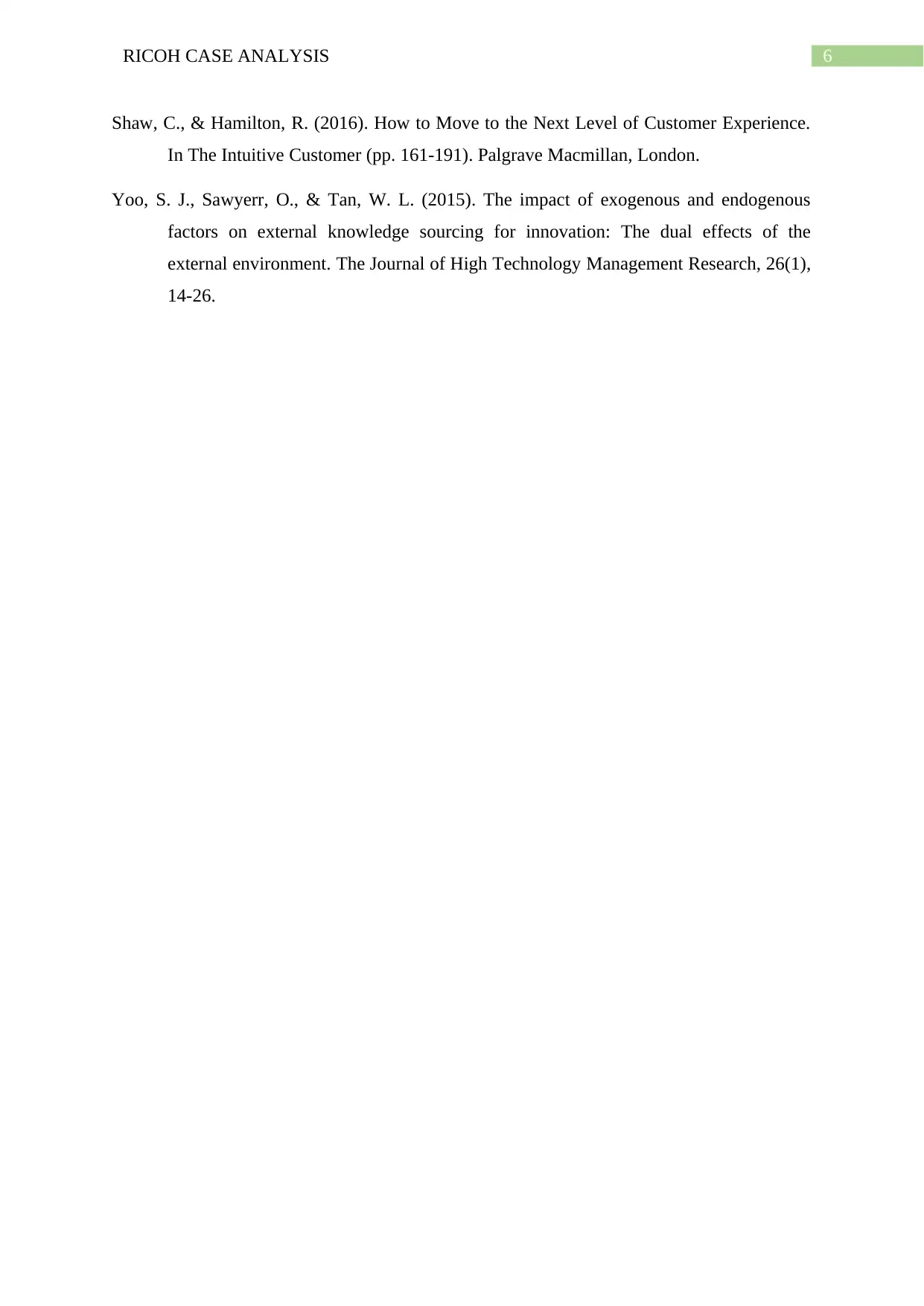
6RICOH CASE ANALYSIS
Shaw, C., & Hamilton, R. (2016). How to Move to the Next Level of Customer Experience.
In The Intuitive Customer (pp. 161-191). Palgrave Macmillan, London.
Yoo, S. J., Sawyerr, O., & Tan, W. L. (2015). The impact of exogenous and endogenous
factors on external knowledge sourcing for innovation: The dual effects of the
external environment. The Journal of High Technology Management Research, 26(1),
14-26.
Shaw, C., & Hamilton, R. (2016). How to Move to the Next Level of Customer Experience.
In The Intuitive Customer (pp. 161-191). Palgrave Macmillan, London.
Yoo, S. J., Sawyerr, O., & Tan, W. L. (2015). The impact of exogenous and endogenous
factors on external knowledge sourcing for innovation: The dual effects of the
external environment. The Journal of High Technology Management Research, 26(1),
14-26.
1 out of 7
Related Documents
Your All-in-One AI-Powered Toolkit for Academic Success.
+13062052269
info@desklib.com
Available 24*7 on WhatsApp / Email
![[object Object]](/_next/static/media/star-bottom.7253800d.svg)
Unlock your academic potential
Copyright © 2020–2025 A2Z Services. All Rights Reserved. Developed and managed by ZUCOL.




